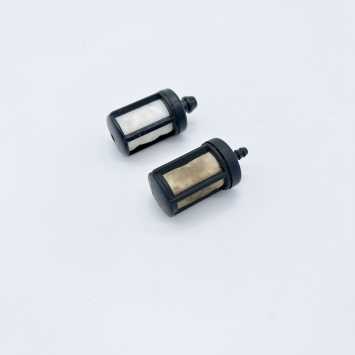City & Guilds chainsaw maintenance assessment 201 includes schedule questions around the fuel and oil filters. Whilst they are often seen as relatively minor components, a wider discussion on fuel oils, re-filling and cap cleanliness can evolve.
They consist of ‘demonstrate knowledge’ questions for obvious safety reasons. Thinking about these different requirements will help you understand or unlock the City & Guilds Assessment schedule. Look out for and mark with a different highlighter the sections where you will have to:
- Demonstrate Knowledge - via conversational style questioning you show understanding of basic safety or maintenance steps.
- Demonstrate - a practical demonstration of a skill or task
- Assessor observes - the assessor will check you are doing something safely, for example, wearing gloves when sharpening
Fuel filters are generally located at the rear of the saw inside the fuel tank which is often integrated into one rear handle.
When working with fuel and oil filters apply the following safety precautions:
- Work on a saw empty of fuel
- Choose a well-ventilated area
- Avoid any sources of ignition
- Use gloves when handling fuels and oils
- Use approved containers for storage
- Get organised with spill protection – mats or trays
Clean around the caps before releasing them. Prevention is better than cure!
Fuel filters
Removal - use a round hooked wire to ‘fish’ out the filter, which is on the end of a small, flexible fuel hose. This hose usually is long enough to allow the filter to be extracted still connected. Hold on tight, as the tension in the hose may snap it back into the tank.
Check for damage and excessive contamination via visual inspection. If there is contamination, then a replacement is sensible given the low cost and difficulty of cleaning such a fine filter.
On the replacement, ensure that the filter can move freely and that caps are replaced securely, especially the Stihl one where it can appear closed only to drop a tank of fuel down your leg.
Oil Filters
Oil filters are generally located at the opposite end of the saw, the tank being integral with the alloy moulding forming the saw body and crankcase. The delivery hose is often much shorter than the fuel side. This makes removal less straightforward through the filling hole and is best done via the clutch side after removing the oil pump.
Inspection is best done with the tank empty. A torch can reveal if contamination is preventing oil flow. Use a solvent to wash out the filter when the tank is empty. Rinse, check and repeat as necessary.
Prevention is better than cure – keep the cap area clean and fuel mixing free of debris, and you may never have to maintain these components!


